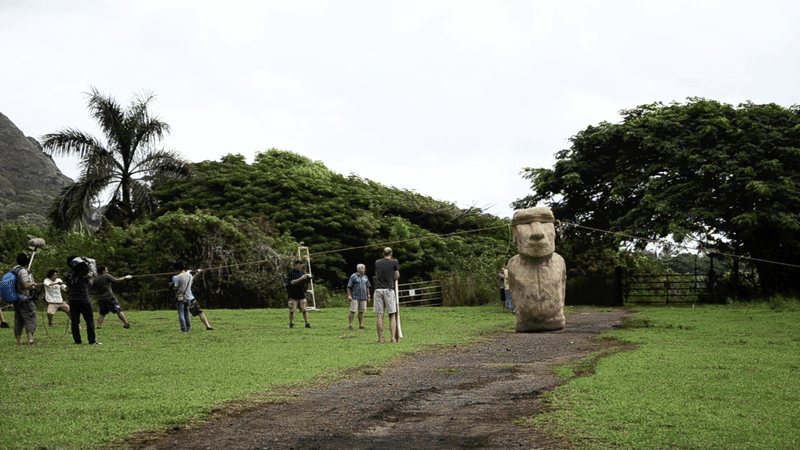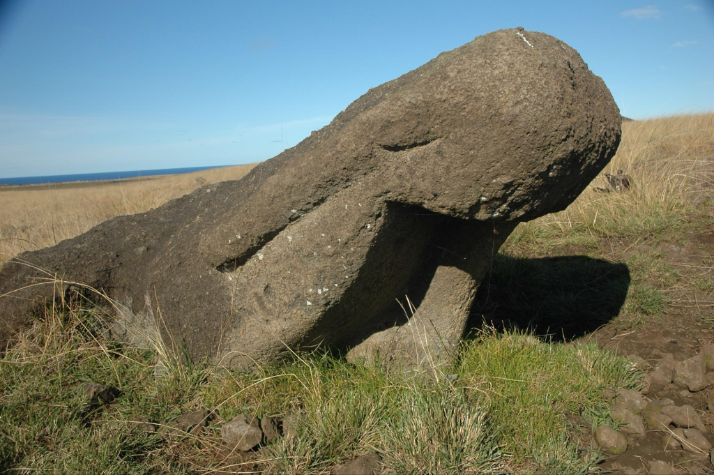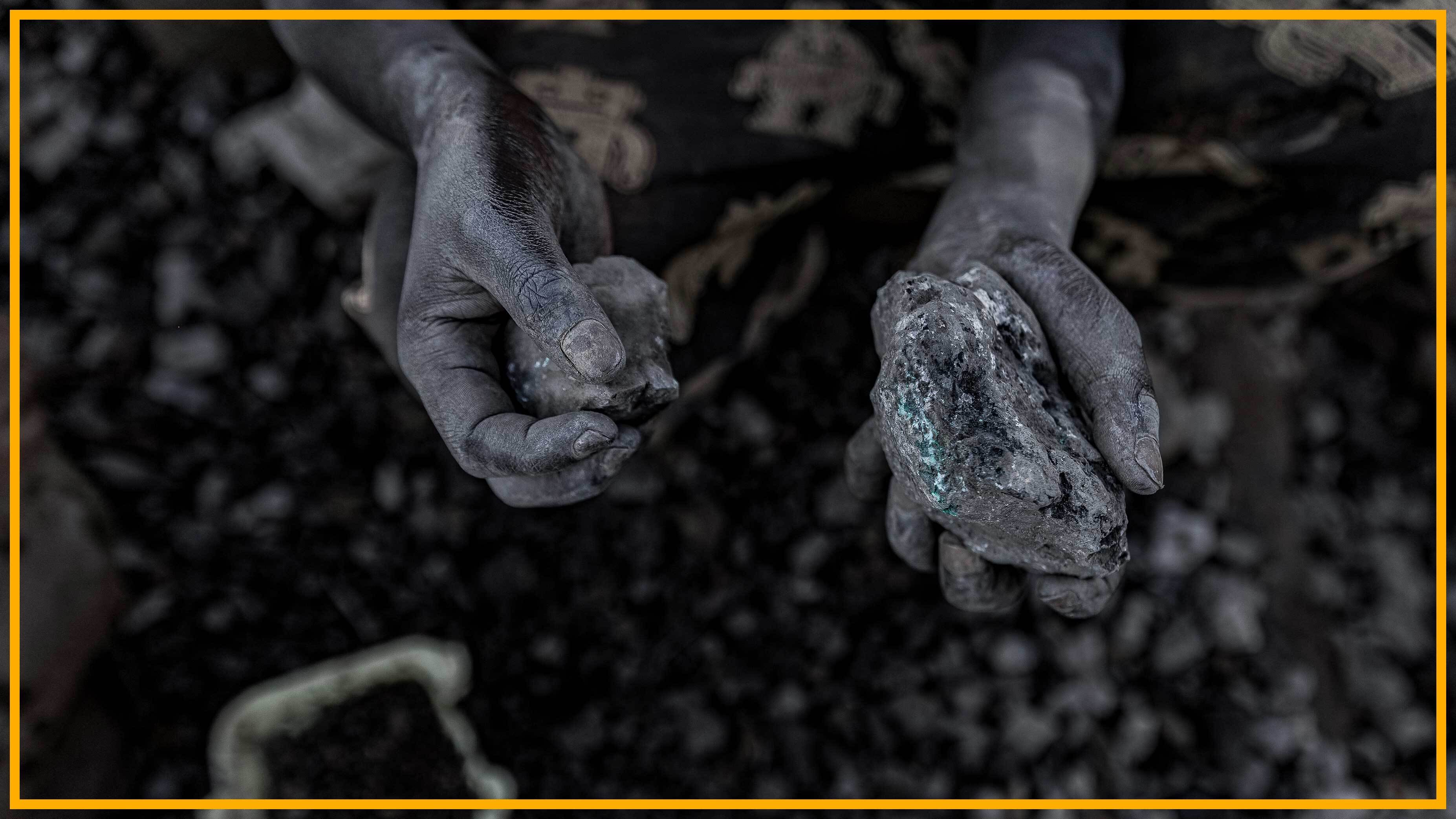Easter Island statues may have 'walked' thanks to 'pendulum dynamics' and with as few as 15 people, study finds
Simple physics may explain how the Easter Island statues could "walk" miles with only a handful of people, but the debate over their transport is far from over.

Easter Island's giant moai statues could "walk" with only three things in place: a small group of people, long ropes and the use of pendulum dynamics, a new study finds.
Researchers have long debated how the Indigenous people of Easter Island, also known as Rapa Nui, moved their huge human-faced moai statues — which can weigh dozens of tons, on average — centuries ago. Now, a new study finds that physics was on their side.
Anthropologists made the discovery after realizing that incomplete moai statues that had been discarded shortly after being quarried were missing certain details. They noticed that before being carved into their final ceremonial design, the statues had been crafted to have a low center of mass and a forward lean to assist their transport, the team wrote in the study, which was published in the November 2025 issue of the Journal of Archaeological Science.
The team virtually recreated the moai and found that, with the help of three ropes and anywhere between five and 60 people, the moai could have taken steps averaging 35 inches (89 centimeters) long to travel across the Rapa Nui landscape.
Together, these findings provide "compelling" evidence against the traditional view that Rapa Nui communities needed vast amounts of resources and huge numbers of people to move the moai from the Rano Raraku quarry to their final position, the authors wrote.
"What we found is the fact that statues were moved with very small numbers of people in an amazingly ingenious way," study co-author Carl Lipo, a professor of anthropology at Binghamton University in New York, told Live Science. "In a way that when you see it happen you're like 'of course they moved it that way,'"
The "walking" moai experiment
Rapa Nui was first settled around 1,000 years ago. Today, the people of Rapa Nui share this 63-square-mile (164 square kilometers) island with at least 962 moai: Gigantic stone statues depicting heads and torsos ranging from 3.7 feet (1.1 meters) to 32.6 ft (9.8 m) tall. The ceremonial positions of the moai are an average of 6.2 miles (10 km) from where they were quarried.
Get the world’s most fascinating discoveries delivered straight to your inbox.
The way the Rapa Nui people moved these megaliths centuries ago, however, has been hotly debated. One hypothesis is that the statues "walked," with Lipo and his team conducting a televised "experiment" in 2012 showing a team of 18 people "walking" a scaled 4.8 ton (4.4 metric ton) replica a distance of 328 feet (100 m) in 40 minutes.
"It wasn't an experiment in the sense of we weren't testing out specific ideas about numbers of people," Lipo said. "Our goal was simply: What's the least number of people we can get to move this thing."
He admitted that testing the physics to see how many people were needed to move the moai should have been done before the test run on the replica. To slot this missing piece into the puzzle, Lipo and study co-author Terry Hunt, a professor of anthropology at the University of Arizona, built virtual 3D models of the 62 moai found along centuries-old roads — dubbed "road moai."
This revealed that these statues had a distinctive forward lean of around 6 degrees to 15 degrees, shifting their center of mass in such a way that the moai would topple if they stood by themselves. In fact, the center of mass was consistently lower than the final moai statues, which the authors suggest provided the stability needed for the sideways rocking generated as part of the "walks."

The road moai also have a D-shaped base, which acted as a "pivot point" for each step, the authors wrote. The lack of eye sockets in all road moai, but their presence in all final moai, evidences the fact that the finishing touches were carved when they arrived at their final destination, they added.
The team also modeled the physics of the "walking" moai to determine the workforce requirements and the travel time based on 65 feet to 98 feet (20 to 30 m) long ropes. This included incorporating the mass of the moai and their irregular shapes and calculating the force needed to get the "walking" motion started.
They found that, depending on the moai's gigantic size, 15 to 60 people were needed to start the movement and five to 25 to continue it, indicating that this mode of transport was "remarkably efficient," the authors wrote in the study.
Tugging on the ropes created a rocking motion, causing the base to pivot and "step" forward. Pendulum dynamics meant the steps became less effortful once initiated.
The researchers calculated that the moai could "walk," on average, 1,000 feet (310 m) per hour, with the larger moai not necessarily being slower because they had longer strides. An average-size moai would have taken around 11,000 steps for a 6.2 mile (10 km) journey.
An outside take
This research is "an ingenious and worthwhile contribution to the discussion," Sue Hamilton, an archaeologist and professor of prehistory at University College London who was not involved in the research, told Live Science in an email.
However, Hamilton said that "the data presented are consistent with a range of interpretations, not just those of the authors." For example, she said the road moai may have been engineered differently because they served a different ceremonial purpose, were made by different people with varying levels of expertise or were a trend from a particular point in time.
Hamilton also emphasized that this research shows one possibility of how the people of Rapa Nui moved the moai, but that there are other plausible hypotheses. "The current work by the authors further demonstrates the technical possibility of upright movement of the statues (moai), but it does not prove that it happened," Hamilton said.
For Lipo and Hunt, the critics of the walking moai hypothesis "have yet to offer plausible alternatives that account for the full range of evidence," they wrote in the study.

Sophie is a U.K.-based staff writer at Live Science. She covers a wide range of topics, having previously reported on research spanning from bonobo communication to the first water in the universe. Her work has also appeared in outlets including New Scientist, The Observer and BBC Wildlife, and she was shortlisted for the Association of British Science Writers' 2025 "Newcomer of the Year" award for her freelance work at New Scientist. Before becoming a science journalist, she completed a doctorate in evolutionary anthropology from the University of Oxford, where she spent four years looking at why some chimps are better at using tools than others.
You must confirm your public display name before commenting
Please logout and then login again, you will then be prompted to enter your display name.
